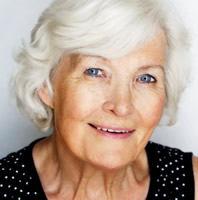
Jill was diagnosed with diabetes in 1951 – when she was just 22 months old. So she’s lived with Type 1 diabetes virtually all her life.
She has seen some changes, some of which were so long ago that she can only vaguely remember them.
Open about diabetes
Jill’s very open about her diabetes, as maybe you would be if you’ve essentially always had it. “I’ve never been secretive about it,” she says, “I think the more open you are with people, the better. After all, at some time you might need their help. It’s not the first thing I say when I meet someone new, but I don’t worry about telling people if I need to explain things.”
Diabetes diagnosis
She can’t remember being diagnosed , but she’s been told that she became a very thirsty baby and started to waste away. “The local GP were a bit slow picking up on it, but they’d never seen a baby so young with it. I was put in hospital and it was back in the days when parents were only allowed to come in during visiting hours. My mother said I used to scream when she had to leave me. It hasn’t marked me for life though, I’m lucky not to remember it.”
Not in the family
As far as she is aware, Jill did not have diabetes in the family, though she muses, “it wasn’t a long time before then that people with diabetes just died, so maybe there had been someone in the family who had it but died of it before I was born and I did not know about them.”
Jill’s right that only a generation before diabetes would have been a killer. At the time of her diagnosis, he mother was told that Jill ‘would not make old bones.’ There were no tips for people with diabetes at the time.
60 years later
Sixty years later and Jill is doing just fine, thank you very much! She’s on two injections a day (she uses animal insulin) and does four or five blood tests daily too. “I like to know what’s going o,” she says, but she also remembers the many years she was diabetic and did not have a blood test meter. “The technology was not there’” she says, “it just wasn’t possible when I was growing up.”
She also says that in the early days there were not a lot of rules or regulations about diet, “I ate what I felt I needed. All we had back then was the ‘wee’ test – five drops of urine plus 10 drops of water in a test tube then pop a tablet in and it would fizz then change colour. If you were blue or green you were all right. If it went orange then you were in trouble!”
Blood testing and carb counting
Blood testing and carb-counting came in later.
As a child Jill was treated by a local GP whom she recalls was “a nice, kind man.” In her teens she went to a different clinic and she recalls there were “very fierce, if anything went wrong you felt it was your fault.
We counted carbohydrate ‘exchanges’ and had to calculate our insulin. It felt like leaping over hurdles all the time, with loads of maths involved. I hated it, and didn’t stick to the rules!”
Despite what sounds like rebellion, Jill kept her head and had a sensible approach to her diabetes and she knows she’s doing fine, although she also feels that her regime is now a little old-fashioned by modern NHS standards.
Good care from the NHS
“I get good care, but most people are on the human insulins and on four injections a day, so the younger nurses aren’t used to someone on bovine insulin taking just two a day. I do seem to be a part of a small and dwindling group of people on animal insulin, but it works for me. I’ve learned what my body needs and what makes it work, and why change?”
One thing Jill thinks has also changed, unlike her insulin but like the technological advances in blood testing, is that “Medical people are much easier to talk to now, it feels like more of a partnership, where you’re in control of your health and they are assisting you, not telling you off all the time!”

